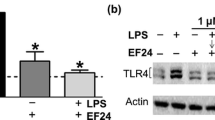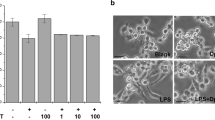Abstract
We investigated effects of magnesium sulfate (MgSO4) on modulating lipopolysaccharide (LPS)–macrophage binding and cluster of differentiation 14 (CD14) expression. Flow cytometry data revealed that the mean levels of LPS-macrophage binding and membrane-bound CD14 expression (mCD14) in differentiated THP-1 cells (a human monocytic cell line) treated with LPS plus MgSO4 (the LPS + M group) decreased by 28.2% and 25.3% compared with those THP-1 cells treated with LPS only (the LPS group) (P < 0.001 and P = 0.037), indicating that MgSO4 significantly inhibits LPS–macrophage binding and mCD14 expression. Notably, these effects of MgSO4 were counteracted by L-type calcium channel activation. Moreover, the mean level of soluble CD14 (sCD14; proteolytic cleavage product of CD14) in the LPS + M group was 25.6% higher than in the LPS group (P < 0.001), indicating that MgSO4 significantly enhances CD14 proteolytic cleavage. Of note, serine protease inhibition mitigated effects of MgSO4 on both decreasing mCD14 and increasing sCD14. In conclusion, MgSO4 inhibits LPS–macrophage binding through reducing CD14 expression. The mechanisms may involve antagonizing L-type calcium channels and activating serine proteases.







Similar content being viewed by others
References
Ahmed LA (2012) Protective effects of magnesium supplementation on metabolic energy derangements in lipopolysaccharide-induced cardiotoxicity in mice. Eur J Pharmacol 694(1–3):75–81
Bufler P, Stiegler G, Schuchmann M, Hess S, Kruger C, Stelter F et al (1995) Soluble lipopolysaccharide receptor (CD14) is released via two different mechanisms from human monocytes and CD14 transfectants. Eur J Immunol 25(2):604–610
Cai C, Shi X, Korff S, Zhang J, Loughran PA, Ruan X et al (2013) CD14 contributes to warm hepatic ischemia-reperfusion injury in mice. Shock 40(2):115–121
Chen CP, Tsai PS, Huang CJ (2012) Anti-inflammation effect of human placental multipotent mesenchymal stromal cells is mediated by prostaglandin E2 via a myeloid differentiation primary response gene 88-dependent pathway. Anesthesiology 117(3):568–579
Chen Z, Shao Z, Mei S, Yan Z, Ding X, Billiar T, Li Q (2018) Sepsis upregulates CD14 expression in a MyD88-dependent and Trif-independent pathway. Shock 49(1):82–89
Chmielinska JJ, Tejerro-Taldo MI, Mak IT, Weglicki WB (2005) Intestinal and cardiac inflammatory response shows enhanced endotoxin receptor (CD14) expression in magnesium deficiency. Mol Cell Biochem 278(1–2):53–57
Dong JF, Cruz MA, Aboulfatova K, Martin C, Choi H, Bergeron AL et al (2008) Magnesium maintains endothelial integrity, up-regulates proteolysis of ultra-large von Willebrand factor, and reduces platelet aggregation underflow conditions. Thromb Haemost 99(3):586–593
El-Tanbouly DM, Abdelsalam RM, Attia AS, Abdel-Aziz MT (2015) Pretreatment with magnesium ameliorates lipopolysaccharide-induced liver injury in mice. Pharmacol Rep 67(5):914–920
Ferrero E, Jiao D, Tsuberi BZ, Tesio L, Rong GW, Haziot A et al (1993) Transgenic mice expressing human CD14 are hypersensitive to lipopolysaccharide. Proc Natl Acad Sci USA 90:2380–2384
Gao F, Ding B, Zhou L, Gao X, Guo H, Xu H (2013) Magnesium sulfate provides neuroprotection in lipopolysaccharide-activated primary microglia by inhibiting NF-kappaB pathway. J Surg Res 184(2):944–950
Hopkins HA, Monick MM, Hunninghake GW (1995) Lipopolysaccharide upregulates surface expression of CD14 on human alveolar macrophages. Am J Physiol 269(6Pt1):L849–L854
Kew KM, Kirtchuk L, Michell CI (2014) Intravenous magnesium sulfate for treating adults with acute asthma in the emergency department. Cochrane Database Syst Rev 5:CD010909
Landmann R, Knorf HP, Link S, Sansano S, Schumann R, Zimmerli W (1996) Human monocyte CD14 is upregulated by lipopolysaccharide. Infect Immun 64(5):1762–1769
Le-Barillec K, Si-Tahar M, Balloy V, Chignard M (1999) Proteolysis of monocyte CD14 by human leukocyte elastase inhibits lipopolysaccharide-mediated cell activation. J Clin Investig 103(7):1039–1046
Le-Barillec K, Pidard D, Balloy V, Chignard M (2000) Human neutrophil cathepsin G down-regulates LPS-mediated monocyte activation through CD14 proteolysis. J Leukoc Biol 68(2):209–215
Lee MY, Huang CH, Kuo CJ, Lin CL, Lai WT, Chiou SH (2015) Clinical proteomics identifies urinary CD14 as a potential biomarker for diagnosis of stable coronary artery disease. PLoS One 10(2):e0117169
Lin CY, Tsai PS, Hung YC, Huang CJ (2010) L-type calcium channels are involved in mediating the anti-inflammatory effects of magnesium sulphate. Br J Anaesth 104(1):44–51
Lopez-Castejon G, Brough D (2011) Understanding the mechanism of IL-1β secretion. Cytokine Growth Factor Rev 22(4):189–195
Ma L, Wu X-Y, Zhang L-H, Chen W-M, Uchiyama A, Mashimo T et al (2013) Propofol exerts anti-inflammatory effects in rats with lipopolysaccharide-induced acute lung injury by inhibition of CD14 and TLR4 expression. Braz J Med Biol Res 46(3):299–305
Ma S, Chen C, Cao T, Bi Y, Zhou J, Li X et al (2017) Mitigation effect of proanthocyanidin on secondary heart injury in rats caused by mechanical trauma. Sci Rep 7:44623
Molteni M, Gemma S, Rossetti C (2016) The role of Toll-like receptor 4 in infections and noninfectious inflammation. Mediat Inflamm 2016:6978936
Park BS, Lee JO (2013) Recognition of lipopolysaccharide pattern by TLR4 complexes. Exp Mol Med 45:e66
Pedrinaci S, Ruiz-Cabello F, Gomez O, Collado A, Garrido F (1990) Protein kinase C-mediated regulation of the expression of CD14 and CD11/CD18 in U937 cells. Int J Cancer 45(2):294–298
Pham CT (2008) Neutrophil serine proteases fine-tune the inflammatory response. Int J Biochem Cell Biol 40(6–7):1317–1333
Prestigiacomo V, Weston A, Messner S, Lampart F, Suter-Dick L (2017) Pro-fibrotic compounds induce stellate cell activation, ECM-remodelling and Nrf2 activation in a human 3D-multicellular model of liver fibrosis. PLoS One 12(6):e0179995
Rosadini CV, Kagan JC (2017) Early innate immune responses to bacterial LPS. Curr Opin Immunol 44:14–19
Senft AP, Korfhagen TR, Whitsett JA, Shapiro SD, Levine AM (2005) Surfactant protein-D regulates soluble CD14 through matrix metalloproteinase-12. J Immunol 174(8):4953–4959
Shin MK, Shin SW, Jung M, Park H, Park HE, Too HS (2015) Host gene expression for Mycobacterium avium subsp. paratuberculosis infection in human THP-1 macrophages. Pathog Dis 73(5):ftv031
Sonna LA, Hirshman CA, Croxton TL (1996) Role of calcium channel blockade in relaxation of tracheal smooth muscle by extracellular Mg2+. Am J Physiol 271(2 Pt 1):L251–L257
Su SC, Lin CC, Tai HC, Chang MY, Ho MR, Babu CS et al (2016) Structural basis for the magnesium-dependent activation and hexamerization of the Lon AAA+ protease. Structure 24:676–686
Sugawara S, Nemoto E, Tada H, Miyake K, Imamura T, Takada H (2000) Proteolysis of human monocyte CD14 by cysteine proteinases (gingipains) from Porphyromonas gingivalis leading to lipopolysaccharide hyporesponsiveness. J Immunol 165(1):411–418
Sugimoto J, Romani AM, Valentin-Torres AM, Luciano AA, Ramirez Kitchen CM, Funderburg N et al (2012) Magnesium decreases inflammatory cytokine production: a novel innate immunomodulatory mechanism. J Immunol 188(12):6338–6346
Sun X, Zemel MB (2008) Calcitriol and calcium regulate cytokine production and adipocyte-macrophage cross-talk. J Nutr Biochem 19(6):392–399
Tada H, Sugawara S, Nemoto E, Takahashi N, Imamura T, Potempa J, Travis J, Shimauchi H, Takada H (2002) Proteolysis of CD14 on human gingival fibroblasts by arginine-specific cysteine proteinases from Porphyromonas gingivalis leading to down-regulation of lipopolysaccharide-induced interleukin-8 production. Infect Immun 70(6):3304–3307
Takeshita S, Nakatani K, Kawase H, Seki S, Yamamoto M, Sekine I et al (1999) The role of bacterial lipopolysaccharide-bound neutrophils in the pathogenesis of Kawasaki disease. J Infect Dis 179(2):508–512
Takeshita S, Nakatani K, Tsujimoto H, Kawamura Y, Sekihe I (2000) Detection of circulating lipopolysaccharide-bound monocytes in children with gram-negative sepsis. J Infect Dis 182(5):1549–1552
Troelstra A, Antal-Szalmas P, de Graaf-Miltenburg LA, Weersink AJ, Verhoef J, Van Kessel KP et al (1997) Saturable CD14-dependent binding of fluorescein-labeled lipopolysaccharide to human monocytes. Infect Immun 65(6):2272–2277
Weglicki WB, Mak IT, Chmielinska JJ, Tejero-Taldo MI, Komarov A, Kramer JH (2010) The role of magnesium deficiency in cardiovascular and intestinal inflammation. Magnes Res 23(4):S199–S206
Wei Y, Chen J, Hu Y, Lu W, Zhang X, Wang R, Chu K (2018) Rosmarinic acid mitigates lipopolysaccharide-induced neuroinflammatory responses through the inhibition of TLR4 and CD14 expression and NF-κB and NLRP3 inflammasome activation. Inflammation 41(2):732–740
Zhu T, Zhang L, Ling S, Duan J, Qian F, Li Y et al (2014) Scropolioside B inhibits IL-1β and cytokines expression through NF-kappaB and inflammasome NLRP3 pathways. Mediat Inflamm 2014:819053
Acknowledgements
The authors thank Ms. Tai-Hsin Chang and Ms. Ching-Yun Chang for their excellent laboratory technical assistance. This study was supported by a grant from the Ministry of Science and Technology, Taiwan (MOST 105-2314-B-303-001-MY3), awarded to CJH.
Author information
Authors and Affiliations
Contributions
YYC and CJH contributed to the study concept and design; data collection, analysis, and interpretation; and writing and critical revision of the article. TYL, MCK, TYC, CFC, and CSW contributed to data analysis and interpretation as well as writing and critical revision of the article.
Corresponding author
Additional information
Publisher's Note
Springer Nature remains neutral with regard to jurisdictional claims in published maps and institutional affiliations.
Rights and permissions
About this article
Cite this article
Chang, YY., Lin, TY., Kao, MC. et al. Magnesium sulfate inhibits binding of lipopolysaccharide to THP-1 cells by reducing expression of cluster of differentiation 14. Inflammopharmacol 27, 249–260 (2019). https://doi.org/10.1007/s10787-019-00568-7
Received:
Accepted:
Published:
Issue Date:
DOI: https://doi.org/10.1007/s10787-019-00568-7




